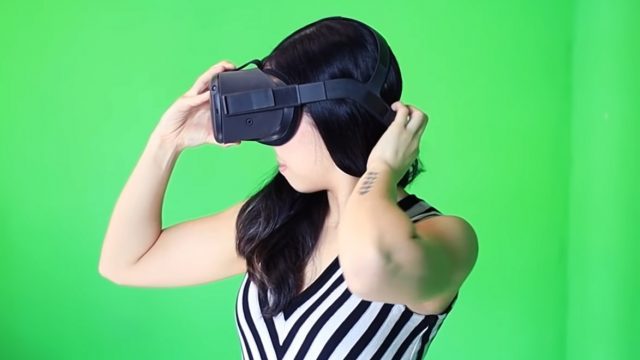The Oculus Quest has been my daily driver for standalone VR ever since its release. I wanted to share my personal experiences and things that I do to get the most out of the headset. Here are 20 tips & tricks for new users (and maybe even a few for seasoned Questers).
Cas and Chary VR is a YouTube channel hosted by Netherland-based duo Casandra Vuong and Chary Keijzer who have been documenting their VR journeys since 2016. They share a curated selection of their content with extra insights for the Road to VR audience.
1. Comfort
The Oculus Quest can be front heavy for many. It may sound like a no-brainer, but we see people wearing headsets like Quest sub-optimally all the time. Before you research any comfort accessories, let’s make sure you’ve got the right approach to fitting the headset.
This is how I do it: First, loosen the top velcro. Then make sure the back strap is low and cradles the base of your head. Ideally, the headset should be primarily supported by a good on the mound of the back of the head, with the headset’s weight supported by the top strap, so tighten the top strap once you fit that fit on the back of your head.
 Only after you’ve done the above should you adjust the side straps while moving the headset up and down until the visuals look clear. If you rely too much on tightening the side straps for a ‘grip like’ fit between your face and the back of your head, you’re in for discomfort. Again, the top strap should be doing most of the lifting, while the side straps should only be as tight as necessary to keep the headset from moving out of place.
Only after you’ve done the above should you adjust the side straps while moving the headset up and down until the visuals look clear. If you rely too much on tightening the side straps for a ‘grip like’ fit between your face and the back of your head, you’re in for discomfort. Again, the top strap should be doing most of the lifting, while the side straps should only be as tight as necessary to keep the headset from moving out of place.
2. Comfort Mods & Accessories
If tip #1 doesn’t help, then you can buy comfort accessories or make one yourself. Here are two free DIY comfort comfort mod ideas:
- Counterweight: Tape something heavy together like a pair of AA batteries. Then use Velcro or anything else you have laying around to attach it to the back of the headset. A power bank can be a good choice too because it doubles as weight and extra battery for your headset.
- Use your hair (if it’s long): Tie your hair in a ponytail and put it through the hole of the headset. Your ponytail will act as a counterweight.
3. Measure and Set Your IPD
IPD is short for interpupillary distance; this is the distance between the centers of the pupils of your eyes. You can use the IPD slider at the bottom of the headset to move the lenses to match your IPD. If you don’t do this, your visuals will be blurry, and will likely make using the headset less comfortable.
You can use apps on your phone or online to measure your IPD but I prefer easily measuring it with a ruler in front of a mirror. Just align the end of the ruler to one eye, then close that eye and look out the other; the number directly underneath the second eye is your IPD. Ideally this is done with a milimeter ruler, but you can easily convert from inches to milimeters online.
If you wear glasses, your eye doctor will most likely have your exact IPD number. You can request it or go for another eye check.
You can also skip direct measurement and estimate it by just using the slider. Put on the headset and look at something sharp and well defined (like text). Close one eye and look at the text directly through the center of the lens. Move the slider back and forth until you find where the sharpest position is. This should put you in the ballpark of your IPD, but a direct measurement will be more reliable and accurate.
Use the included lanyards in the box and make sure to wear them every time you play to prevent throwing your controllers away when you are fully immersed in a game. You may think you’d never be foolish enough to really throw your controller when throwing something in the game, but natural reflexes and muscle memory can easily override conscious thought, especially when you’re deeply immersed. And you’d be far from the first… even I’ve thrown a controller before!
5. Optimal Tracking
The Oculus Quest tracking should work well out of the box, but if you’re having issues, here’s some things to consider.
Quest looks for clusters of small invisible infrared lights on the ring of the controllers to understand where they are. If you’re having trouble with controller tracking, make sure that your play space doesn’t have any clusters of small lights that might look like the tracking dots to the headset. That could include a mirror (which would reflect the controller’s own tracking lights), a chandelier, or holiday string lights.
The headset also tracks its own position by looking at the room around you. It needs to be able to make out features in the room, which means if it’s too bright or too dark tracking may not work well. As a rough gauge, Oculus says Quest can track well if a room is bright enough to comfortably read a book.
The easiest way to tell how well Quest can see the environment is to turn on the ‘pass-through’ view which shows you what the world looks like through the headset’s eyes. If you turn on the pass-through view and you can easily make out your room, the headset should have plenty of light. In rare cases it’s possible for it to be too bright, but generally that would take a bright sunny day (or a bright sunny way seen through a window). While a single overexposed (blown out) window in your room shouldn’t be an issue, the more visible area the headset can see, the better (so closing your blinds could help).
The tracking system also works better when there’s clear shapes in the room around you. So if you somehow find yourself playing in a room with no furniture, flat lighting, and white walls, you might see tracking issues. The same could happen if you’re a streamer planning to use a green-screen room.
6. Playing in the Dark
If for some reason you really want to be able to play Quest in a dark area, you can use an infrared illuminator to ‘light’ the area with infrared light (which the headset uses to track) while keeping the area dark in the visible spectrum.I haven’t tried this method myself yet, but it seems fun for outside play at night.
7. Playspace
Ok, now you should also figure out your playspace. The recommended space of 2 x 2 meters is good enough for most games, but the bigger the area you have, the better.
If you have only a small area, get a floormat or cut up a yoga mat and put it at the center of your playspace. Tape something like a bottle cap on it so that you can feel where your ‘front’ position is. If you step too far you’ll feel yourself stepping off of the mat and know to move back to the center. We are using a Proximat, which is built with VR users in mind, but it’s a little more expensive.
8. Motion Sickness
Motion sickness is probably the number one cause that scares people away from VR, which is a shame as, from personal experience VR is generally very comfortable, but some games you’ll come across have intense motion that could make you dizzy. If you pay attention to these tips however, you’ll avoid risking motion sickness and you may even become less sensitive to it with practice.
Ease yourself into it. Pay attention to the ‘Comfort Level’ of apps and games as listed on their Oculus store page. Though it might be tempting, don’t start with games like rollercoaster simulators! Just like real-life rollercoasters can cause motion sickness, VR coasters can too. Start simpler and try those later.
Games which have no ‘virtual’ movement will be the most comfortable—the ones where you physically move around your playspace to navigate. Beat Saber, and Superhot VR are among many great Quest games with no virtual movement. There’s a free demo available on the store for both games so you can try before you buy!
Also, don’t push yourself. If you start to feel nauseous or uncomfortable, stop playing for a while. ‘Pushing through it’ doesn’t work; quitting while you’re ahead is always the best choice when it comes to motion sickness.
If you still feel off after taking a break, try drinking ginger tea and get back into the headset only after you feel better again.
9. Use Your Body to Play
So this is a tip that you might forget about once you are used to games that use artificial motion with your joystick. People tend to forget to use their real-life bodies when in VR even though their playspace is big enough for them to move around.
For example, sometimes you are standing near a virtual table, but not quite close enough to reach an item on it. Your first instinct might be just to use your joystick to get closer, but don’t forget that you can simply take a step forward in the real world to get closer. The same goes for ducking and crouching. It’s much more fun to crouch for real than with a button. Moving ‘for real’ helps prevent motion sickness too (and makes games more immersive).
10. Controller Grip
When you play a movement-intensive game like Beat Saber you might notice the battery covers of your controllers occasionally sliding off depending upon how you grip. Some people find that very annoying, so if you want to get rid of that, a little bit of tape can help. Or you can get one of the Mamut Grip accessories.
11. Settings
Oculus Quest has gotten many updates since launch. Significant updates, for example, added support for hand-tracking and Oculus Link. Improvements keep coming, so it’s worth it to check what’s changed every so often.
Check your software version by going to ‘Settings’ and then ‘About’; you may even have an update available that you haven’t gotten yet. Then you can scroll through the settings and check if there’s something that you would find handy. Also check the ‘Experimental’ section of the settings for a look at some early test features.
12. Oculus Store & Game Tips
The Oculus Store has sales every so often on games too. If you’re sure you are buying a Quest, then it might be worth it to check the offers even before you got your Quest.
If you’ve ever bought any games for Oculus PC, then it is also worth it to check the Oculus Cross-buy Apps list. These are games you only need to buy once and will be available on both PC and Quest.
It’s probably also good to know that the Oculus Store has an excellent refund policy. If you find a game isn’t for you, you can refund it if you played for less than two hours and make the request within 14 days. You can initiate your request through your purchase history page.







